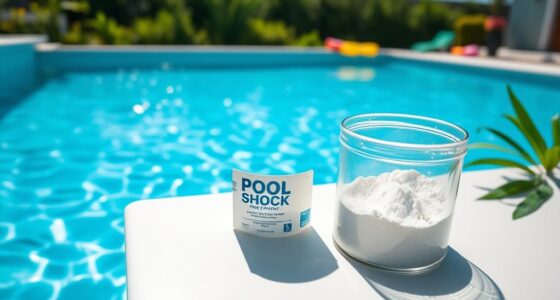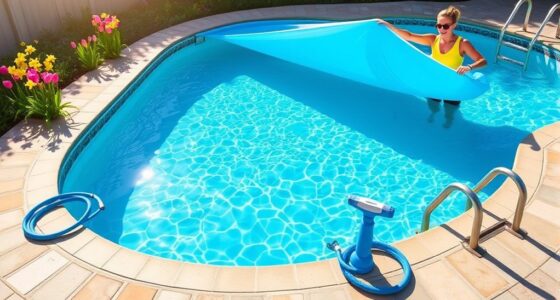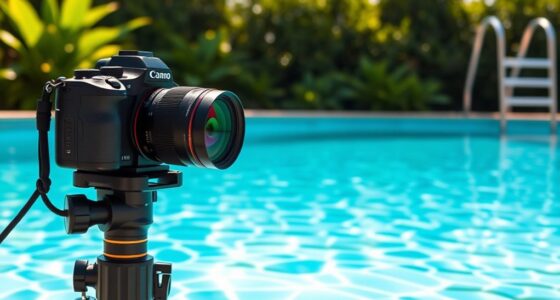To keep your pool safe and clear, maintaining proper pH and alkalinity levels is essential. Aim for a pH of 7.2–7.6 and alkalinity between 80–120 ppm, which helps prevent corrosion, scaling, and irritations. Regular testing and adjustments guarantee water stays balanced, improving sanitizer efficiency and swimmer comfort. If you want to learn simple ways to monitor and correct your pool chemistry, keep going to discover effective tips and techniques.
Key Takeaways
- Maintaining proper pH (7.2–7.6) ensures water clarity, swimmer comfort, and effective sanitizer performance.
- Total alkalinity (80–120 ppm) buffers pH fluctuations, preventing swings and protecting pool surfaces.
- Regular testing with accurate tools helps monitor and adjust pH and alkalinity levels precisely.
- Proper chemical adjustments (using muriatic acid, soda ash, or baking soda) stabilize water chemistry.
- Balanced pH and alkalinity minimize corrosion, scaling, and irritation, extending pool equipment life.
Understanding Ph and Its Role in Pool Chemistry

Understanding pH is vital for maintaining balanced pool chemistry because it directly affects water clarity, comfort, and the effectiveness of sanitizers. pH measures how acidic or alkaline your pool water is on a scale from 0 to 14, with 7 being neutral. The ideal pH range for pools is typically between 7.2 and 7.6, or around 7.4. If the pH is too low (acidic), water can become corrosive, damaging equipment and irritating skin and eyes. If it’s too high (alkaline), water can become cloudy, and chlorine won’t work effectively. Maintaining the proper pH ensures your pool remains clear, comfortable, and safe. Regular testing and adjustments are vital to keep the pH within this perfect range. Incorporating smart testing devices can help monitor pH levels more accurately and conveniently.
The Significance of Total Alkalinity in Water Balance

Maintaining proper total alkalinity helps buffer pH fluctuations, keeping your pool water stable. It also prevents corrosion of equipment and scaling on surfaces, saving you repair costs. Additionally, balanced alkalinity guarantees water clarity and an inviting, clean appearance. Proper alkalinity levels are essential for effective pH control, ensuring a safe and enjoyable swimming environment. Regular testing and adjustments can help maintain these alkalinity levels for optimal water quality.
Buffering Ph Fluctuations
Buffering pH fluctuations is essential for keeping your pool water stable and clear. Total alkalinity acts as a buffer, neutralizing acids and bases that cause pH swings. When acids are introduced, bicarbonates absorb the excess hydrogen ions, preventing a sharp pH drop. Conversely, if bases are added, bicarbonates release hydrogen ions, stopping pH from rising too quickly. This buffering capacity, primarily from bicarbonate ions, maintains consistent pH levels, reducing “pH bounce” and “pH lock.” Proper alkalinity levels—between 80 and 120 ppm—ensure your water remains balanced, protecting your equipment and enhancing swimmer comfort. Regular testing and adjustments keep your pool’s pH stable, minimizing the need for frequent chemical corrections and ensuring clear, healthy water. Additionally, monitoring buffering capacity helps prevent sudden pH changes that could harm swimmers or damage pool equipment.
Preventing Corrosion and Scaling
Total alkalinity plays a crucial role in preventing both corrosion and scaling in your pool water. When alkalinity drops below 80 ppm, water becomes corrosive, causing metal components like ladders, heaters, and pumps to deteriorate. Acidic conditions can also stain and etch pool surfaces, leading to costly repairs. Conversely, high alkalinity above 120 ppm promotes scaling, with calcium carbonate precipitating out of solution. This buildup clogs equipment, reduces efficiency, and damages surfaces. Both extremes compromise the longevity of your pool’s surfaces and equipment, increasing maintenance costs. Maintaining proper alkalinity ensures your water remains balanced, preventing corrosive and scale-forming conditions. Proper alkalinity levels help maintain a stable pH, which is essential for overall water balance. This balance not only protects your pool’s surfaces and equipment but also saves you money by reducing repairs and chemical usage over time.
Maintaining Water Clarity
Proper alkalinity levels directly influence your pool’s water clarity. When alkalinity is too high, it can cause particles to form that don’t dissolve properly, leading to cloudy water. Conversely, low alkalinity makes your water more prone to pH swings, which can also cloud the pool. Maintaining the ideal range of 80 to 120 ppm ensures the water remains clear and inviting. Regular testing is essential to catch fluctuations early. If alkalinity is low, adding sodium bicarbonate can help raise it; if too high, you might need to dilute or adjust with other chemicals. Monitoring alkalinity regularly helps prevent chemical imbalances and ensures stable water chemistry. Balanced alkalinity stabilizes pH, reduces particle formation, and supports effective sanitation. Keeping alkalinity in check makes your pool look pristine and keeps your water safe for swimmers. Additionally, understanding how alkalinity interacts with pH can further optimize your water chemistry and prevent issues before they arise.
How Ph Levels Affect Chlorine Efficiency and Sanitation
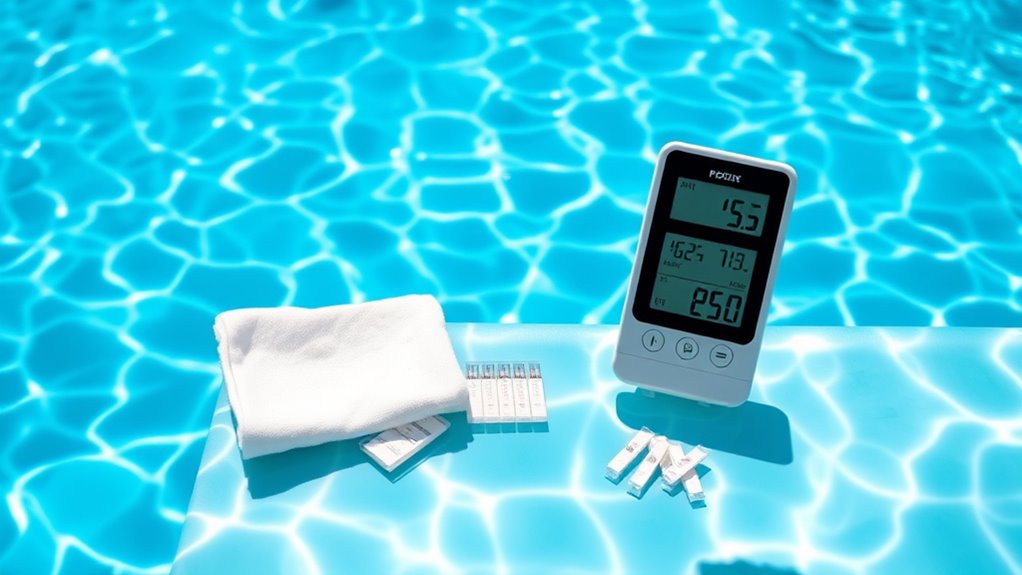
pH levels play a crucial role in determining how effectively chlorine disinfects your pool. When pH rises above 7.2, chlorine’s ability to sanitize drops sharply, with free chlorine activity falling from about 80% at pH 7.0 to under 10% at pH 8.5. At pH 7.5, chlorine works at roughly 45%, but by pH 8.0, its effectiveness drops to around 25%. The best disinfection occurs between pH 7.2 and 7.4, balancing sanitation and pool material safety. Higher pH shifts chlorine from hypochlorous acid (HOCl), the active disinfectant, to hypochlorite ion (OCl⁻), which is less effective. Maintaining proper pH is also essential to prevent damage to pool equipment and surfaces over time. Additionally, understanding the contrast ratio helps you keep the water clarity optimal, ensuring the pool is both safe and inviting for swimmers.
The Impact of High and Low Alkalinity on Pool Components
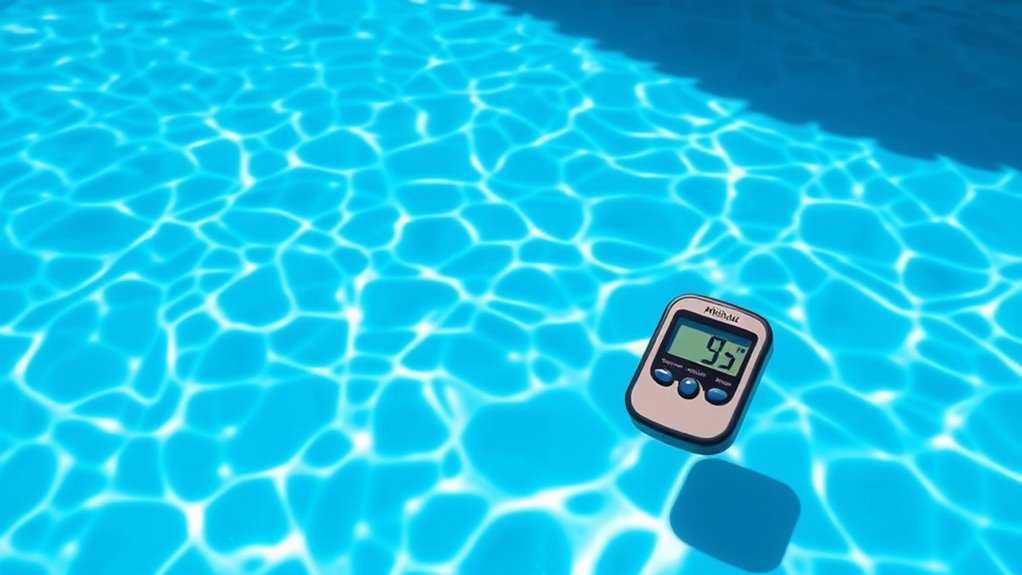
Maintaining balanced alkalinity levels is key to preventing damage and ensuring your pool functions smoothly. When alkalinity is too high, your water can become cloudy due to mineral precipitation, and scale buildup may form on walls, tiles, and steps, creating rough surfaces. High alkalinity also promotes calcium deposits and can lead to etching if pH exceeds 8.3. For your equipment, excess scale can clog filters, reduce pump and heater efficiency, and shorten lifespan, increasing maintenance needs. Water clarity suffers, with murky water and poor circulation caused by clogged filters and stagnant zones. Conversely, low alkalinity creates corrosive water that damages surfaces, causing etching and staining, and accelerates deterioration of pool finishes. Metal components like ladders and heaters are also at risk, leading to rust and leaks. Maintaining proper venting and regular inspections can help prevent some of these issues and prolong the life of your pool components.
Strategies for Adjusting and Maintaining Proper Ph and Alkalinity
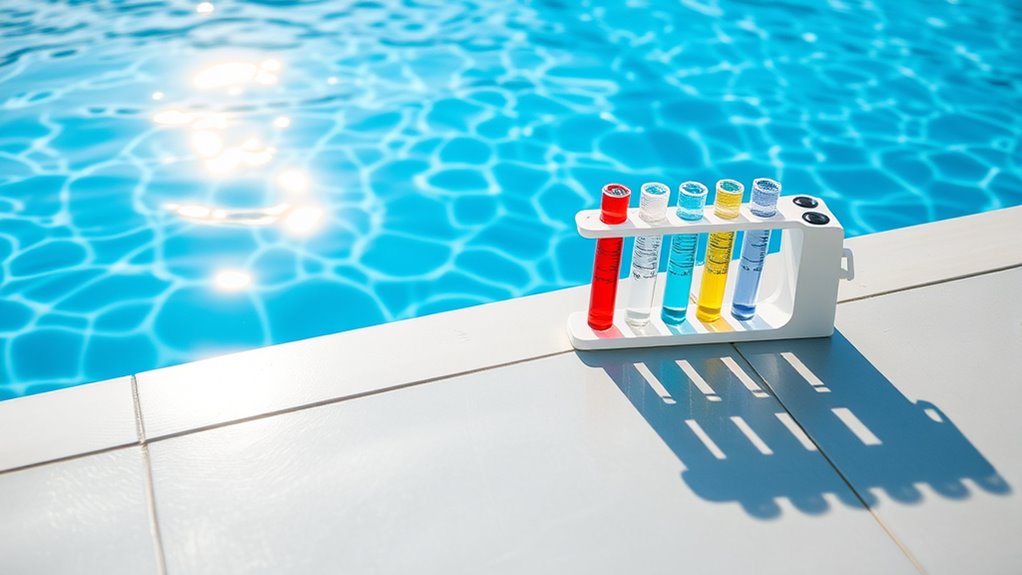
Adjusting your pool’s pH and alkalinity levels requires careful chemical application and proper testing. To raise pH, use a pH increaser with sodium carbonate (soda ash), calculating the dosage based on your pool size and following product instructions. Dissolve the soda ash in water before adding it around the pool perimeter with the pump running for even distribution. Retest after a few hours to ensure the pH is within 7.2 to 7.8. You can also use baking soda to slightly raise pH and alkalinity, adding it gradually while retesting frequently. Proper testing techniques are essential to prevent overcorrection and maintain water safety. Aeration through fountains or waterfalls can naturally increase pH over time. To lower pH and alkalinity, use muriatic acid or sodium bisulfate carefully, adding in small doses around the pool while the pump runs. Always recheck after adjustments to confirm proper balance. Chemical application and monitoring are crucial for maintaining a safe and balanced swimming environment.
The Relationship Between Water Balance and Swimmer Comfort
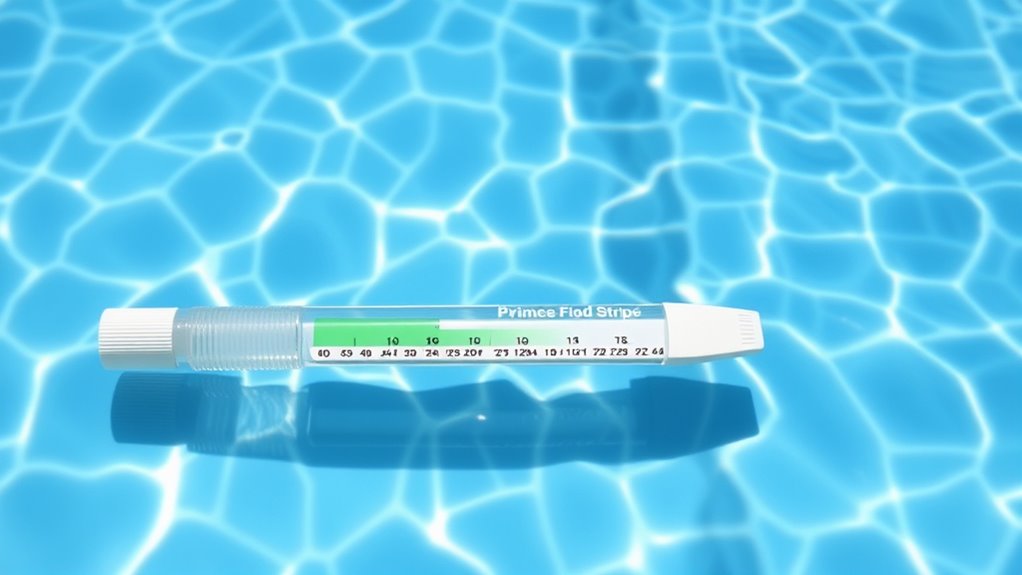
Water balance plays a crucial role in ensuring swimmer comfort by influencing both water clarity and skin or eye irritation. When pH drops below 7.0, you’ll notice red, itchy eyes and skin discomfort, while high pH above 8.0 causes cloudy water and scaling. Maintaining a pH between 7.2 and 7.8, ideally around 7.4 to 7.6, keeps water comfortable and clear. Proper alkalinity, between 80 and 120 ppm, buffers pH fluctuations, preventing irritations caused by sudden changes. Imbalanced water chemistry leads to irritation, scaling, and reduced sanitation effectiveness. When water is balanced, chlorine works efficiently, reducing harmful bacteria and microbiological risks. Additionally, stable chemistry prevents corrosion of pool equipment, protecting the water quality and swimmer comfort over time. Regular testing and adjustments are essential to maintain optimal water chemistry, ensuring a safe and pleasant swimming environment.
Tips for Regular Testing and Monitoring of Pool Water Chemistry
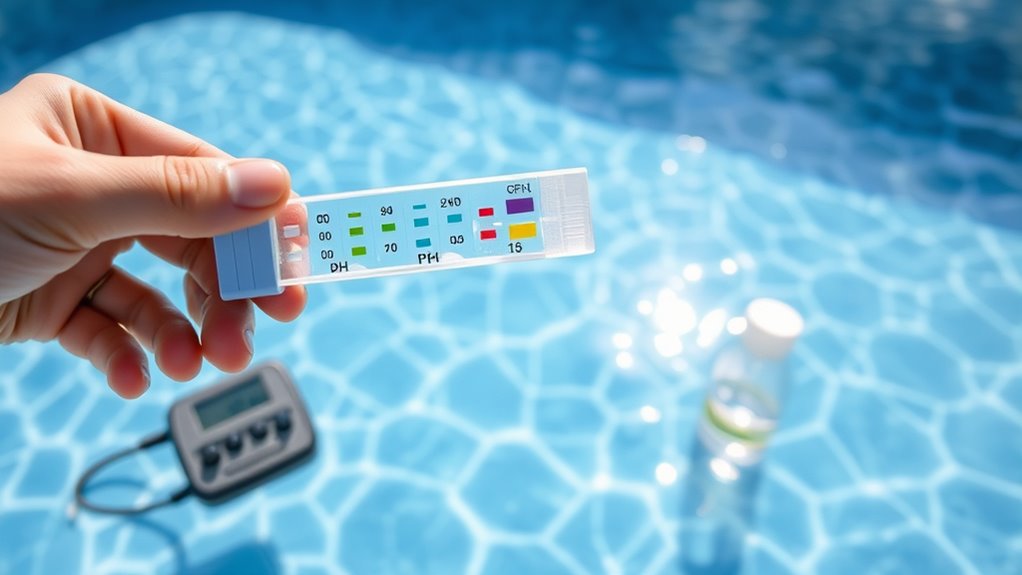
To keep your pool water balanced, you need to test regularly using accurate tools like test strips or digital testers. Consistent testing helps catch issues early, so you can make timely adjustments to pH, alkalinity, and chlorine levels. Be sure to record your results and adjust your chemical levels as needed to maintain safe, clear water. Regular testing ensures that you maintain proper chemical balance and water clarity, preventing problems before they become costly or unsafe. Properly maintaining your water chemistry is essential for a healthy swimming environment.
Use Accurate Testing Tools
Using accurate testing tools is essential for maintaining proper pool water chemistry and ensuring a safe, comfortable swimming environment. Digital testers with electronic sensors offer quick, precise readings of pH, chlorine, alkalinity, and calcium hardness, making them ideal for regular checks. Photometric test kits use light and color to deliver laboratory-level accuracy for key parameters like pH and cyanuric acid. Test strips provide convenience for quick assessments, while Taylor test kits combine advanced chemistry with visual methods for greater precision. Drop-count titrations require minimal technique but deliver reliable results by counting drops until the color shifts. Regular calibration and maintenance of your testing tools are critical to ensure ongoing accuracy and reliability. Properly interpreting test results is just as important as the testing process itself to maintain a balanced pool environment. Whichever method you choose, guarantee your tools are calibrated, clean, and stored properly, and always follow the manufacturer’s instructions to keep your testing accurate and consistent.
Test Consistently and Often
Regular testing is the key to keeping your pool’s water chemistry balanced and safe. You should test your water 2 to 3 times weekly for pH and chlorine levels, adjusting frequency based on usage and weather conditions. After heavy rain, storms, or extreme temperatures, test more often to catch fluctuations. For alkalinity, check weekly to help stabilize pH and prevent damage. During pool startup or when water is unstable, test daily and reduce once stable. Use the following table to guide your testing schedule:
| Situation | Testing Frequency |
|---|---|
| Regular use | 2-3 times per week |
| Heavy rainfall or storms | More frequently |
| Pool startup | Daily initially |
| Cooler months | Bi-weekly or monthly |
| Hot weather or heavy use | 2-3 times weekly |
Consistent testing guarantees your pool stays balanced and safe. Regular testing not only prevents potential water imbalances but also helps detect early signs of chemical fluctuations, such as pH imbalances, saving you time and money on repairs or treatments.
Record and Adjust Regularly
Consistently recording your pool’s water chemistry results is essential for maintaining balance and catching issues early. Use a dedicated log or digital spreadsheet to track pH, alkalinity, chlorine, weather, and usage conditions after each test. Include details like date, time, chemical additions, and test results to identify trends. Review your records weekly to spot fluctuations that may require adjustments before problems develop. Regularly calibrate your test kits or consult professionals to ensure accuracy. When alkalinity is outside the target range (80-120 ppm), adjust gradually with baking soda or acids, retesting after each change. Keep pH between 7.2 and 7.8, addressing deviations promptly. Accurate testing methods are crucial for reliable results, so ensure your supplies are properly stored and within their expiration dates. Additionally, understanding your test kit is vital for proper interpretation of results. By maintaining diligent records and timely adjustments, you keep your pool water balanced, safe, and inviting.
Frequently Asked Questions
How Often Should I Test My Pool’s Ph and Alkalinity?
You should test your pool’s pH 2 to 3 times a week during peak swimming season to keep water comfortable and balanced. For alkalinity, testing once a week usually suffices. If there’s heavy rain, pool parties, or chemical adjustments, increase testing frequency to guarantee everything stays in check. Regular testing helps prevent algae, damage, and irritation, keeping your pool safe and enjoyable.
Can Natural Water Sources Affect Pool Ph and Alkalinity Levels?
Ever wonder how natural water sources influence your pool’s chemistry? They definitely can. Hard water, rich in minerals like calcium and magnesium, raises both pH and alkalinity. Rainwater, being acidic, temporarily lowers pH and alkalinity levels. Soil runoff and organic debris also impact acidity. You need to test regularly because these natural factors constantly shift your pool’s balance, making proper adjustments essential for safe, clear water.
What Are the Signs of Imbalanced Ph and Alkalinity in My Pool?
If your pool’s pH and alkalinity are imbalanced, you’ll notice cloudy or hazy water, which signals trouble. Swimmers might complain about red, irritated eyes, or dry, itchy skin, indicating pH issues. Metal parts could corrode, and surfaces may develop stains or scaling. You might also see stubborn algae growth, a strong chlorine smell, or difficulty maintaining proper sanitizer levels, all pointing to imbalanced pH and alkalinity.
Are There Eco-Friendly Methods to Adjust Pool Water Chemistry?
Yes, you can adjust your pool’s chemistry eco-friendly style. Imagine reducing chemicals while keeping your water perfect—minerals like copper and silver naturally sanitize, CO₂ injection stabilizes pH without harsh acids, and baking soda safely balances alkalinity. Natural enzymes break down organic waste, and solar covers minimize chemical needs. These methods not only protect your pool but also the environment, giving you healthier water with less impact.
How Does Weather Impact Ph and Alkalinity Stability?
Weather considerably impacts your pool’s pH and alkalinity stability. Rain dilutes alkalinity and can lower pH, especially during heavy storms or acid rain. Hot temperatures speed up chemical reactions, causing fluctuations, while cold weather may raise pH levels. High humidity promotes algae growth, destabilizing chemistry. Evaporation concentrates minerals, raising alkalinity and pH. Regular testing and adjustments are essential, especially during weather extremes, to keep your pool balanced and safe.
Conclusion
Maintaining the right pH and alkalinity levels is essential for a safe, clean, and comfortable pool experience. Did you know that even a slight pH imbalance can reduce chlorine effectiveness by up to 90%? Regular testing and adjustments keep your water balanced, preventing issues like cloudy water or equipment damage. Stay proactive with your pool chemistry, and you’ll enjoy crystal-clear water all season long, ensuring every swim is invigorating and worry-free.



